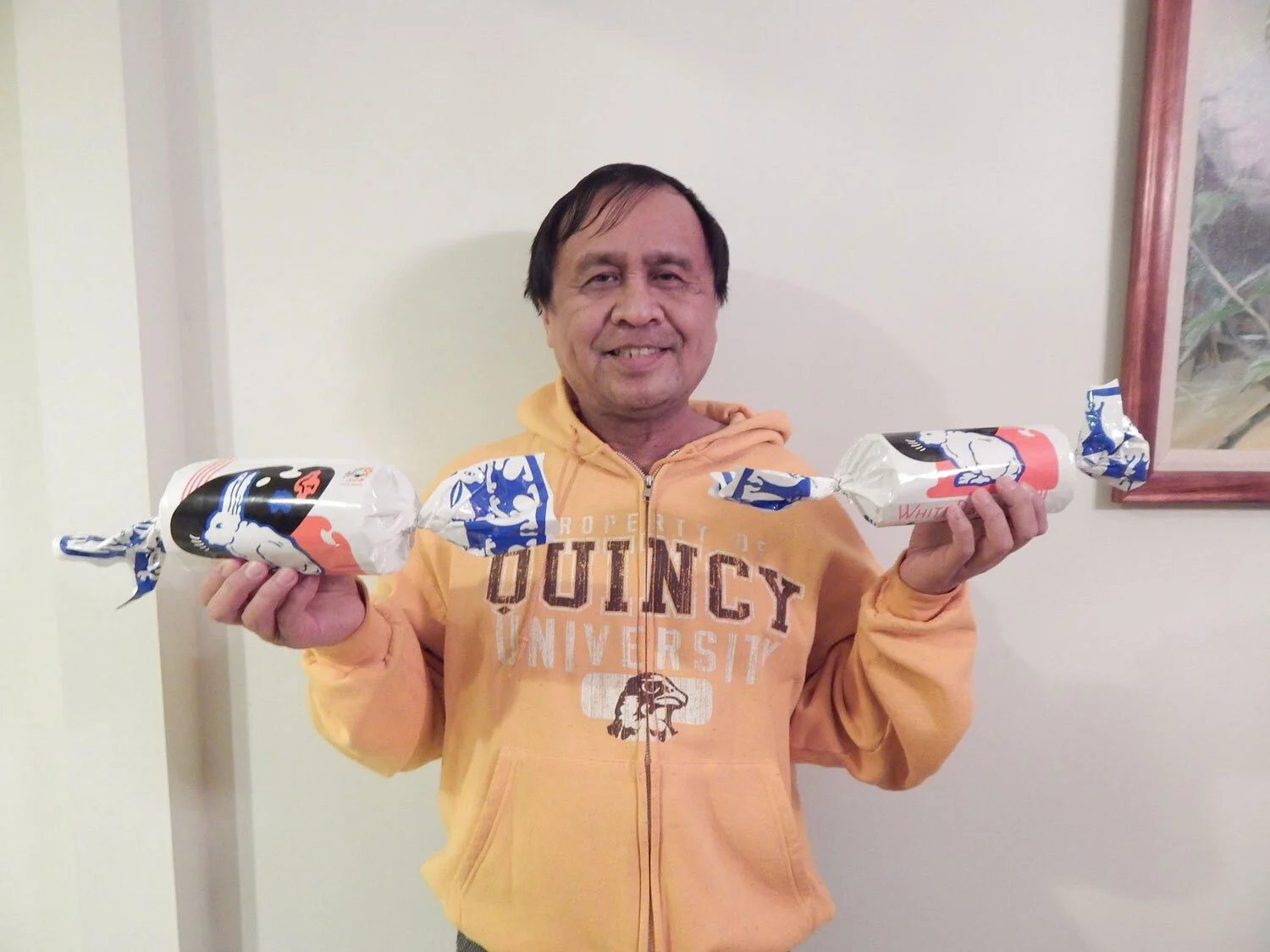Down the ‘White Rabbit’ Hole
/The author with two giant sizes of the White Rabbit
And that’s how my love for the White Rabbit got reignited!
White Rabbit Creamy Candy or White Rabbit is a milk candy made in Shanghai. Formed into cylinders, it is white. Starting out with a hard texture, it gradually becomes soft and chewy. Originally produced by the ABC Candy Factory of Shanghai in 1943, its name was ABC Mickey Mouse Sweets. Because of political upheavals in China, the Mickey Mouse in the logo was eventually deemed as Western (read: capitalistic). As such, it became White Rabbit Creamy Candy in 1959, and the iconic White Rabbit logo and its white, red, and white wrappers were born.
The Ultimate White Rabbit Happiness by Joni Ramos, 2016, acrylic on canvas, 20” x 15”, private collection
I spent my childhood from 1957 to 1964 in the coastal town of Ballesteros, Cagayan, and the only candy that I can remember is White Rabbit. Maybe I had no other choice. For sure, I bought it from ‘Nang Tilyang’s store, which was close to our house.
My friend Marian Ravelo Agas, who now resides in San Diego, also bought White Rabbit from ‘Nang Tilyang’s store on her way to our elementary school. “My best friend, Marilyn Catli, and I used to go to that store maybe twice a week as a treat if we had money,” she reminisced. “Each candy cost about 5 or 10 centavos. We liked White Rabbit because it was not so sweet as the other candies.”
Robert Balarbar, who grew up in Quezon City, vividly remembered the wrappers more than the candy. The first White Rabbit he tasted had a wrapper that stuck to the candy and was messy to separate. In later years, he had the luxury of relishing the candy’s edible rice-paper wrapper.
White Rabbit is a heavenly delight! Visual artist Joni Ramos of Santa Barbara, Pangasinan, humorously elevates the candy in his painting, The Ultimate White Rabbit Happiness (2016). The Laughing Buddha has an oversized White Rabbit on top of his head, and both seemingly float in the sky.
The love for White Rabbit knows no borders. Ming-Gon John Lian, Ed.D., who was my professor in special education at Illinois State University in Normal, Illinois, grew up in Buli, a small rural town in central Taiwan. His White Rabbit memories seemed to have happened just yesterday. “It tasted very good!” he recalled. “Very milky sweet! My family wasn’t wealthy, so Lunar New Year was the time we, the children, had White Rabbit, rather than expensive fancy candies.”
Yvonne Wolf, a television host and producer in Glenview, Illinois, has a flood of memories about White Rabbit:
“The candy melts in your mouth! Because it is white and the rabbit is a symbol used during the Mid-Autumn Festival, I think of the end of summer and being with my family in the summer evening when I was a child in Taiwan.”
Yvonne Liu Wolf interviews the author on her television show, Off The Shelf: Rey E. de la Cruz
For my tour guide Wahyu Nugraha, who grew up in Kediri, a small town in East Java, Indonesia, and is now based in Jogjakarta, White Rabbit brings memories of him helping his mother, Anastasia Sri Indiyah, clean their house. His mother would give him White Rabbit as a reward for helping her. White Rabbit reminds him of his mother, he said.
Tour guide Wahyu Nugraha
Luzheng Liu, M.D., Ph.D., my dermatologist in Lake Bluff, Illinois, grew up in China. White Rabbit is still her favorite candy, and she considers its taste as her standard for judging other candies.
When I shared White Rabbit stories with Lilian Dong, my friend in Shanghai, she was astonished that the candy was popular worldwide. She knew that White Rabbit was a Shanghai product and that it was exported widely. But she found it fascinating that White Rabbit had touched so many lives.
White Rabbit is everybody’s candy. Its taste and accompanying emotions and memories will live forever! It plays a vital role in connecting people, making a better, sweeter world!
Disclosure:
The two giant White Rabbits I am holding in the top photo contains plastic tubes with individually wrapped original White Rabbit milk candies.
*Video follows
Rey E. de la Cruz, Ed.D., Positively Filipino correspondent, writes from Chicagoland when he is not loving the arts and traveling in seven continents. He is the author of the children’s book, Ballesteros on My Mind: My Hometown in the Philippines, which also has Ilocano, Spanish, and Tagalog editions, seven songs, and a film. His baby book and fourth-grade Tagalog diary are in the collection of The Newberry, an independent research library for the humanities in Chicago.
More articles from Rey E. de la Cruz







